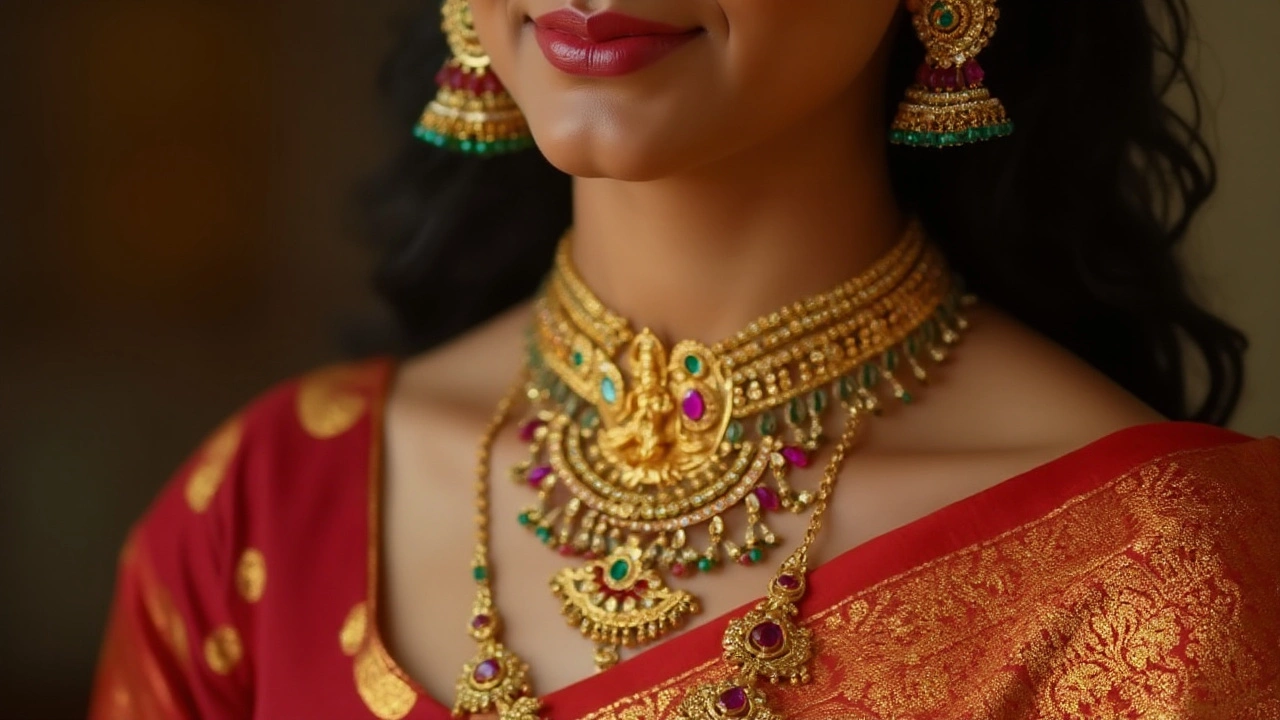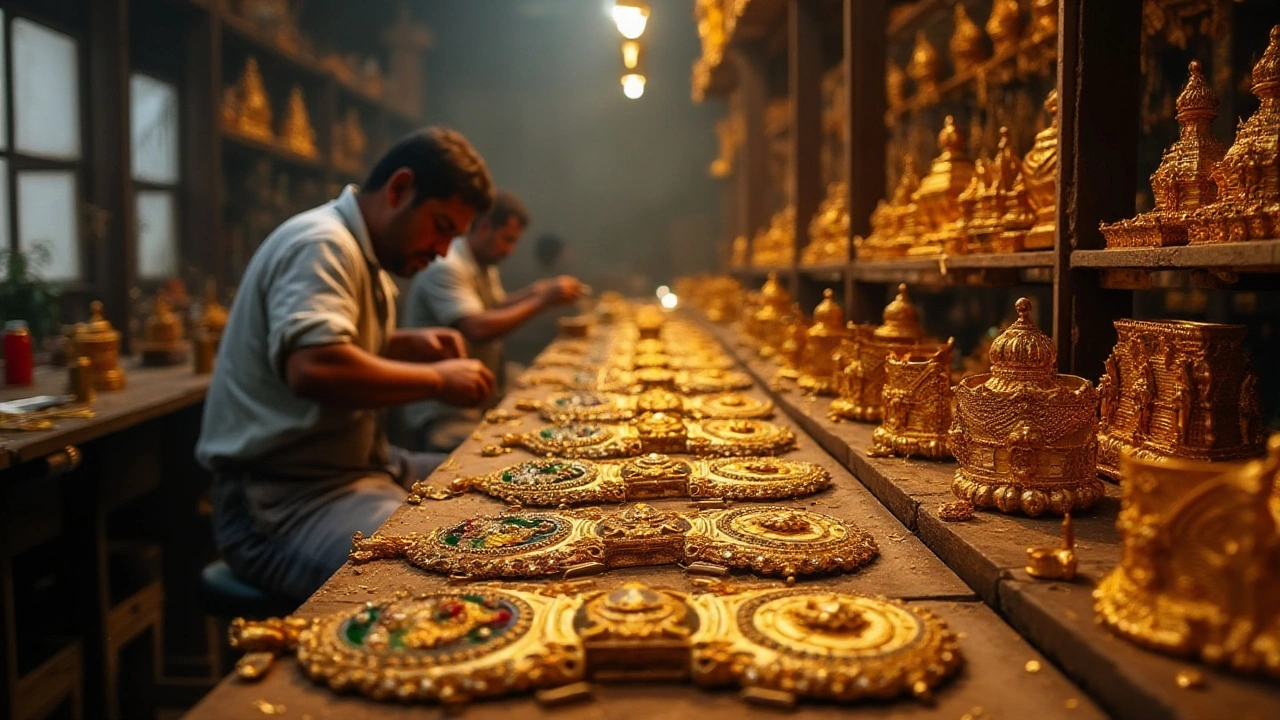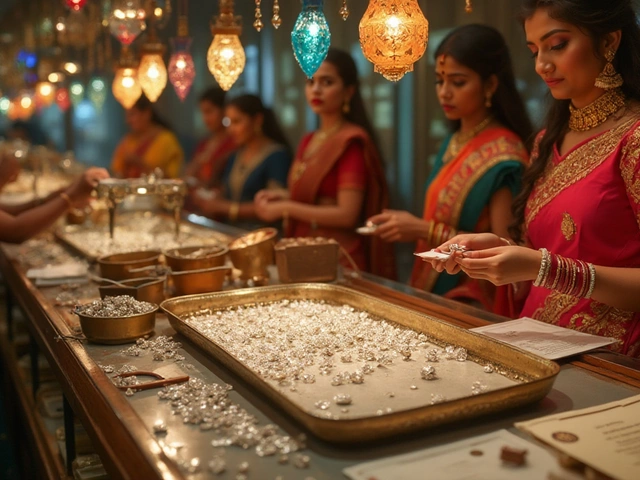
India, a land of mesmerizing beauty and endless charm, is home to some of the most luxurious and historically rich temple jewellery in the world. These pieces, often revered for their intricate designs and precious materials, tell stories of an era gone by, emphasizing not just beauty but also deep cultural and spiritual meanings.
With roots tracing back to ancient times, temple jewellery originated in Southern India and was initially crafted to adorn deities in temples. Over time, these elaborate ornaments became a part of traditional ceremonies and special occasions. Each piece is a work of art, carefully crafted to reflect India's vibrant tapestry and spiritual devotion.
- The History of Temple Jewellery
- Famous Temples and Their Treasures
- Craftsmanship and Techniques
- Symbolism and Spiritual Significance
- Modern Day Influence and Adaptations
- Preservation Efforts and Challenges
The History of Temple Jewellery
Temple jewellery has a rich tapestry deeply woven into the heart of Indian culture, primarily rooted in the resplendent regions of South India. The origins of these magnificent pieces can be traced back to the Chola dynasty, a time when art and culture flourished unabated across the Indian subcontinent. Craftsmanship was not merely a trade; it was a sacred practice handed down through generations, ensuring the skills and traditions were preserved with utmost devotion. Goldsmiths of that era, revered much like the sculptors of stone temples, engaged themselves in creating jewellery that transcended mere adornment, serving as a veneration to the divine.
The primary function of this temple jewellery was to adorn deities, hence each piece carried a spiritual significance along with its aesthetic allure. Deities were dressed in these brilliant creations during religious festivals and daily rituals, transforming the jewellery into a palpable bridge between the mortal and the divine. Interestingly, as centuries passed, these stunning forms of gold and embellishments began proliferating beyond temples. Royal patrons adopted them, and they swiftly became intertwined with the traditional bridal array, further embedding them into India's cultural fabric. Temple jewellery was particularly known for its exquisite carving and use of gold, sometimes set with precious stones, which were believed to harness spiritual energies.
The influence of temple jewellery grew under the Vijayanagara Empire, where elaborate jewels mirrored the architectural opus of the temples, showcasing a synthesis of artistic craftsmanship. Historians note that during this period, temples often housed intricate sculptures that seem almost life-like, bedecked in Indian jewellery. It is documented that in Nayak temples, dancers and queens alike were regaled in this traditional jewellery reflecting both status and piety. An interesting excerpt from the writings of R. Screenivasan, a scholar of Indian temple arts, is quoted saying,
"Temple jewellery sings the hymns of our ancient ethos, hanging gloriously around the necks of deities and devotees alike."
As time unfolded, a parallel evolution saw these adornments transitioning from religious spaces to personal ornaments among common folk and aristocracy. The Grand Annamaya necklace, worn by the dancers of their famed Bharatanatyam dance, performed an important role in keeping the style alive in contemporary settings. Indeed, the craft that originated as a symbol of faith eventually meandered its way into a tribute to tradition, dignity, and elegance, deftly balancing between reverence and regality. Crafting these pieces demanded meticulous precision and utmost artistry, executed predominantly by skilled artisans known within their communities for their unparalleled expertise.
Although traditional temple jewellery might not be widely crafted in modern commercial workshops, the legacy continues to flourish. Whether it's the captivating tales of exquisite creations uncovered in ancient texts or the ones enshrined in cultural memory through art forms, the history of temple jewellery in India remains an everlasting flame of cultural pride and artistic heritage. Such is its timeless beauty and unmatched grandeur that it's celebrated with the same awe and reverence today as it was centuries ago.
Famous Temples and Their Treasures
India's temples are not just places of worship; they are custodians of some of the richest collections of jewellery in the world. These treasures, often hidden away in the sacred vaults, bear witness to an opulent history that blends artistry with spirituality. One such celebrated temple is the Padmanabhaswamy Temple in Kerala, which has gained global attention for its astounding reserves of gold and precious gems. In 2011, a treasure trove worth billions was discovered within the temple's underground vaults, consisting of gold coins, jewellery, and ceremonial objects. Each artifact reflects the immense wealth once held by the erstwhile Travancore Kingdom, emphasizing the significance of temple jewellery throughout the ages.
The Tirupati Venkateswara Temple, another iconic institution, is not only a spiritual hotspot but also home to a vast collection of invaluable ornaments. Devotees from various corners of the world present sacred offerings that include intricate jewellery pieces crafted from the finest materials. The temple's golden crown encrusted with rare diamonds and emeralds is perhaps its most well-known possession, symbolizing both wealth and the deep devotion of its followers. This combination of piety and prosperity gives the temple its unique character, making it a revered destination in the landscape of Indian spiritualism.
Situated in the lush landscapes of Tamil Nadu, the Meenakshi Amman Temple stands as a testament to the intricate craftsmanship unique to South India. The temple's jewellery collection features pieces made from pure gold, decorated with vibrant rubies and emeralds that capture the light in dazzling displays. Many of these ornaments are used to adorn the deities during festivals, creating a mesmerizing scene that captivates all who witness it. The temple's treasures are not only valuable in monetary terms but also play an essential role in its elaborate cultural rituals, highlighting the enduring connection between spirituality and material artistry.
The Jagannath Temple in Puri, Odisha, is another magnificent establishment known for its rich hoard of sacred jewels. Every year, during the famous Rath Yatra festival, the deities are adorned in splendid jewellery, providing a breathtaking spectacle of grandeur and devotion. The collection includes historic pieces that have been passed down through generations, each with its own story to tell. A recent inventory revealed not only the extensive wealth of relics stored in the temple's inner sanctums but also the meticulous care taken by the temple authorities to preserve this heritage for future generations.
“India's temple jewellery collections are a tribute to the nation's artistic genius and divine inspiration,” remarks Indian historian Dr. Ravi Nair in an insightful overview of the country's spiritual heritage. These temples, with their profound religious and cultural history, continue to attract not just tourists but also scholars eager to understand the depth of India's artistic and theological traditions.

Craftsmanship and Techniques
The art of creating temple jewellery in India is a masterful blend of traditional skills, passed down through generations, and detailed attention to design. Each piece of jewellery is meticulously handcrafted, making it more than just an adornment; it's a cultural emblem. The legacy of this craft is woven into the very essence of regions like Tamil Nadu and Karnataka, where artisans spend countless hours moulding and assembling these treasures. These craftsmen employ ancient techniques such as 'Kundala Velai', a method of inlaying stones into a base metal with precision. They transform raw, lustrous gold into exquisite jewellery pieces that resemble historical temple sculptures and motifs, reinforcing the seamless union of artistry and devotion.
Temple jewellery is rich in detail and symbolism, often featuring motifs inspired by Hindu mythology and temple architecture. The skillset required includes mastery of techniques like filigree, granulation, and repoussé, all of which contribute to the intricate designs and texture. Usually, these techniques are combined with embossing, where the metal is worked from the reverse side to create a raised design that stands out with high relief on the jewellery's surface. This process commands an artist's deft hand and patience, as even the smallest flaw can disrupt the symmetry of the design. It is said that the artful complexity mirrors the devotion and spiritual dedication of both the craftsman and wearer.
According to historian Geetha Mehta, "The process of creating temple jewellery is as elaborate as the mythology it depicts, drawing links between artistry and spirituality."
The vibrant colour and sparkle of temple jewellery arise from the gemstones embedded in its construction. Stones like rubies, emeralds, and uncut diamonds are carefully chiseled and placed to enhance the divine depiction of deities and other sacred symbols. The method of stone setting is an art form in itself. Artisans use traditional prongs and bezels to position every stone securely while ensuring visibility and brilliance. The use of precious stones signifies prosperity and harmony, aligning with the spiritual themes that underpin temple jewellery's design ethos. Interestingly, the choice of stone is not merely aesthetic but also messages the wearer's well-being, with each gem often believed to hold specific beneficial properties. To protect this delicate art, attempts have been made to document traditional methods and encourage young artisans to pick up these heirloom skills. A periodic training session and storytelling workshops are arranged by cultural bodies to ensure these exceptional skills survive the pressures of modern mass production methods.
Symbolism and Spiritual Significance
In the heart of India, temple jewellery holds a revered position not just for its opulence but for the deep spiritual symbolism woven into each design. Historically, these precious ornaments adorned the deities within Indian temples, serving as a tangible expression of devotion. Craftsmen dedicated their artistry to create pieces that symbolized prosperity, divinity, and an eternal connection between the earthly and the divine realms. Gold, often considered a divine metal in Indian culture, formed the base for these intricate creations, believed to attract positive energy and divine blessings.
The intricate motifs and designs within temple jewellery are not just decorative but embody significant religious narratives and symbols. For instance, designs often incorporate symbols of flora and fauna which hold special significance. The lotus, a recurring theme, represents purity and divine beauty, while elephants symbolize wisdom and patience. Each element is thoughtfully integrated into the jewellery, creating a spiritual language understood by the devout.
"Temple jewellery is not just about aesthetic appeal, it is a sacred craft that connects the wearer to the universe," says Dr. Anjali Menon, a renowned historian specializing in Indian artefacts.
The spiritual aspect of temple jewellery extends to its use in rituals and ceremonies. During major religious festivals, these ornate pieces are often used to decorate the deities, thus enhancing the sanctity of the occasion. The jewellery serves as an offering, a physical manifestation of faith and devotion, believed to appease the gods and bring divine intervention. For devotees, wearing such jewellery during auspicious occasions is believed to protect from ill fortune and fill life with harmony and joy.
The Modern Interpretation
Even as styles evolve and fashion trends change, the spiritual essence of temple jewellery remains deeply rooted in contemporary adaptations. Today, designers infuse these traditional elements into modern-day accessories, blending age-old symbolism with contemporary aesthetics. This fusion renders the jewellery not only a testament to India’s rich heritage but also a cherished heirloom passed down through generations, keeping traditions alive while also embracing change.
It is this spiritual and symbolic resonance that makes India jewellery in temples a lasting artistic legacy, celebrated not only for its beauty but also for its profound spiritual essence. As the world continues to delve into India’s rich cultural narratives, temple jewellery stands as a beacon of divine artistry, an enduring testament to the country's artistic and spiritual wealth.

Modern Day Influence and Adaptations
In today's fast-paced world, where trends change as quickly as the tides, the timeless allure of India's temple jewellery has found a new and vibrant place. Once solely the embellishment of divine statues, these intricate pieces have made a bold entry into contemporary fashion, captivating both the hearts of traditionalists and modernists alike. The intricate designs, steeped in mystery and cultural significance, resonate strongly with those who appreciate artistry wrapped in history. Fashion designers and jewellery artisans have realized the potential of these age-old designs and are adapting them to cater to a wider, global audience. By infusing modern elements with traditional *temple jewellery* motifs, they are not only preserving a part of India's cultural heritage but also nurturing it.
While originally crafted from pure gold and precious gems, today's pieces may incorporate a variety of materials, such as silver, pearls, and semi-precious stones, allowing for more accessibility without sacrificing the essence of the art. This fusion of old and new can be seen on fashion runways, in designer collections, and even on social media, where influencers showcase stunning pieces, attesting to their growing popularity. A notable event that highlights this blend is the annual Lakme Fashion Week in India, where several designers exhibit modern adaptations of traditional Indian jewellery, drawing inspiration from classic temple designs. In response to this trend, consumer demand has surged for jewellery that blends historical richness with the versatility of everyday wear.
Many brides and grooms today opt for *India jewellery* pieces as part of their wedding trousseau, cherishing them as heirlooms that exude an aura of timeless tradition. Such is the influence of these jewels that prominent figures from the Indian film industry frequently don them at prestigious events, further bolstering their status as symbols of elegance and sophistication. For instance, actress Deepika Padukone made headlines wearing a stunning piece of temple jewellery at a recent award gala, sparking renewed interest among fans and admirers.
"Temple jewellery is not just about aesthetics; it is a celebration of our rich heritage," expresses Meenakshi Mantha, a renowned Indian jewellery designer known for her modern interpretations of classic designs.To understand the changing landscape of temple jewellery consumption, a look at the numbers reveals astonishing growth. A recent survey by the Indian Council of Gem and Jewellery estimates that the demand for traditional jewellery designs in modern formats has increased by 15% over the past three years. This is a testament to the evolving preferences of consumers who seek both beauty and storytelling in their adornments.
However, with adaptation comes challenges. Traditional artisans, who have dedicated their lives to the meticulous craft of temple jewellery, often find themselves balancing between maintaining authenticity and embracing change. There is a profound sense of responsibility towards preserving the soul of these artistic creations, while simultaneously exciting a generation that places a premium on individualism and novelty. Initiatives are now underway to bridge this gap by offering training programs that combine traditional craftsmanship with contemporary design perspectives, ensuring that the legacy of this exquisite art form continues to flourish in an ever-changing world.
Preservation Efforts and Challenges
Preserving India's rich legacy of temple jewellery is as intricate as the designs themselves. Each piece acts as a custodian of the past, holding tales of bygone eras. Yet, the challenges faced in conserving these treasures are manifold. The primary challenge lies in the delicate nature of the materials. Gold, while lasting, requires careful storage to avoid any tarnishing. Gemstones, often used generously in these pieces, pose their own preservation hurdles. Environmental factors such as humidity and extreme temperatures can affect their integrity, threatening the brilliance and the vivid hues of the jewels.
Adding to these challenges is the ever-present threat of theft and illicit trade, which is particularly prevalent for historical pieces that fetch high values on the black market. Government bodies and cultural organizations have been striving to combat this threat through stringent security measures. Around 60% of these efforts are concentrated on enhancing monitoring and securing digital records of these valuables, reducing incidents of loss and unauthorized trades.
A pivotal element in the preservation effort is the involvement of artisans. These skilled craftsmen, whose ancestors might have originally created these very items, play an essential role in restoration projects. However, the waning interest among the younger generation to pursue these traditional crafts presents yet another hurdle. Efforts are underway to reinvigorate interest through workshops and national awards that encourage contemporary artists to delve into the ancient practices and move towards restoring the India jewellery craftsmanship to its historical splendor.
"It is crucial to bridge our glorious past with the present," says Dr. Meenakshi Iyer, Chairwoman of the India Cultural Preservation Society. "Not just for the sake of tradition, but to keep alive the narrative that defines our spiritual and cultural identity."
Preservation is a constant battle, requiring collaboration across several fronts. Institutions such as the Archaeological Survey of India (ASI) and numerous NGOs have been pivotal, organizing landmark exhibitions and funding extensive research. These endeavors aim to document and digitize records of notable jewellery, making information accessible to wider audiences and ensuring historical pieces are recognized, appreciated, and preserved. Preservation is a dance between safeguarding the integrity of these treasures while ensuring they remain an integral part of a living cultural heritage.
To address modern challenges, technologies such as blockchain are being explored, offering a transparent and immutable record of provenance for each significant piece of temple jewellery. These digital solutions promise an innovative approach to both preserving and authenticating the treasures, harnessing modern solutions to age-old challenges. As global awareness and appreciation of rich jewellery grow, so too does the international support for India's preservation initiatives, weaving a broader tapestry of shared global heritage.


